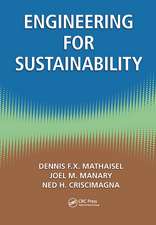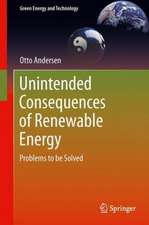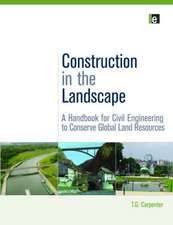Sustainable Resource Use and Economic Dynamics: The Economics of Non-Market Goods and Resources, cartea 10
Editat de Lucas Bretschger, Sjak Smuldersen Limba Engleză Hardback – 24 iul 2007
| Toate formatele și edițiile | Preț | Express |
|---|---|---|
| Paperback (1) | 942.01 lei 6-8 săpt. | |
| SPRINGER NETHERLANDS – 19 noi 2010 | 942.01 lei 6-8 săpt. | |
| Hardback (1) | 947.98 lei 6-8 săpt. | |
| SPRINGER NETHERLANDS – 24 iul 2007 | 947.98 lei 6-8 săpt. |
Preț: 947.98 lei
Preț vechi: 1156.07 lei
-18% Nou
Puncte Express: 1422
Preț estimativ în valută:
181.40€ • 193.98$ • 151.24£
181.40€ • 193.98$ • 151.24£
Carte tipărită la comandă
Livrare economică 18 aprilie-02 mai
Preluare comenzi: 021 569.72.76
Specificații
ISBN-13: 9781402062926
ISBN-10: 1402062923
Pagini: 200
Ilustrații: IX, 231 p.
Dimensiuni: 155 x 235 x 22 mm
Greutate: 0.52 kg
Ediția:2007
Editura: SPRINGER NETHERLANDS
Colecția Springer
Seria The Economics of Non-Market Goods and Resources
Locul publicării:Dordrecht, Netherlands
ISBN-10: 1402062923
Pagini: 200
Ilustrații: IX, 231 p.
Dimensiuni: 155 x 235 x 22 mm
Greutate: 0.52 kg
Ediția:2007
Editura: SPRINGER NETHERLANDS
Colecția Springer
Seria The Economics of Non-Market Goods and Resources
Locul publicării:Dordrecht, Netherlands
Public țintă
ResearchCuprins
to Sustainable Resource Use and Economic Dynamics.- A Dynamic Model of the Environmental Kuznets Curve: Turning Point and Public Policy.- The Optimal Timing of Adoption of a Green Technology.- Can Environmental Regulations Boost Growth?.- General Purpose Technologies and Energy Policy.- Efficient Dynamic Pollution Taxation in an Uncertain Environment.- A New-Growth Perspective on Non-Renewable Resources.- Sectoral Energy- and Labour-Productivity Convergence.- Spatial Evolution of Social Norms in a Common-Pool Resource Game.- Sustainable Motion in Classical Mechanics: An Economics Perspective.
Textul de pe ultima copertă
30 years after the publication of the famous symposium issue of the Review of Economic Studies, which started the neoclassical literature on growth theory and resource economics, this volume seeks to reinforce research efforts in order to provide adequate solutions for today’s challenges in the field of sustainable development. It compiles innovative current research from resource, energy and environmental economics and dynamic economic theory. It contains both new approaches as well as detailed surveys of the existing literature.
The chapters in the book cover a broad range of aspects regarding the relationship between natural resource use and long-term economic development. In particular, the following topics are studied: incentives for adoption and diffusion of clean technology, resource scarcity and limits to growth, international convergence of energy intensity, and the social norms shaping resource depletion.
The topic of this volume is of high interest with regard to the future development of the world economy. In the past two centuries, many countries experienced an unprecedented increase in living standards. At the same time, pollution of the environment increased while the stock of worldwide natural resources declined. Consequently, the concern that environmental restrictions, especially the bounded supply of natural resources end energies, will limit economic development in the long run is widespread. Most prominently, it has been expressed in the prediction of ‘limits to growth’ by the Club of Rome in the 1970s. Today, the notion of ‘sustainable growth’ is widely accepted as a main principle in the theoretical and political discussion. But a general consensus on the consequences for the use of natural capital has still to be established. This holds true not only for economics, but also for interdisciplinary research programs and the public debate. Therefore, more research should be directed at finding and establishing therules for a world society which is intrinsically compatible with its natural environment.
What does sustainability mean for resource and energy use, what are the economist’s predictions for the impact of natural resource use on the welfare of future generations? The different contributions in the present volume shed light on important subjects related to these fundamental questions.
Chapters 2, 3, 6, 8 and 9 are reprinted from Environmental & Resource Economics, Vol. 36, No. 1, 2007.
The chapters in the book cover a broad range of aspects regarding the relationship between natural resource use and long-term economic development. In particular, the following topics are studied: incentives for adoption and diffusion of clean technology, resource scarcity and limits to growth, international convergence of energy intensity, and the social norms shaping resource depletion.
The topic of this volume is of high interest with regard to the future development of the world economy. In the past two centuries, many countries experienced an unprecedented increase in living standards. At the same time, pollution of the environment increased while the stock of worldwide natural resources declined. Consequently, the concern that environmental restrictions, especially the bounded supply of natural resources end energies, will limit economic development in the long run is widespread. Most prominently, it has been expressed in the prediction of ‘limits to growth’ by the Club of Rome in the 1970s. Today, the notion of ‘sustainable growth’ is widely accepted as a main principle in the theoretical and political discussion. But a general consensus on the consequences for the use of natural capital has still to be established. This holds true not only for economics, but also for interdisciplinary research programs and the public debate. Therefore, more research should be directed at finding and establishing therules for a world society which is intrinsically compatible with its natural environment.
What does sustainability mean for resource and energy use, what are the economist’s predictions for the impact of natural resource use on the welfare of future generations? The different contributions in the present volume shed light on important subjects related to these fundamental questions.
Chapters 2, 3, 6, 8 and 9 are reprinted from Environmental & Resource Economics, Vol. 36, No. 1, 2007.
Caracteristici
Most recent approaches to modelling technological change and pollution Surveys existing literature as well as adds to frontier research Provides both theoretical and empirical perspectives























